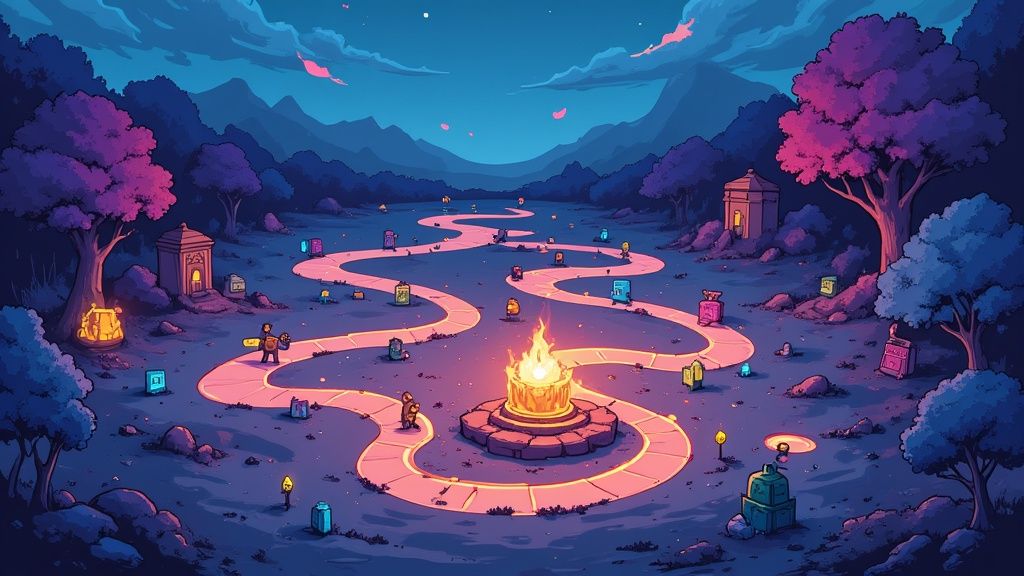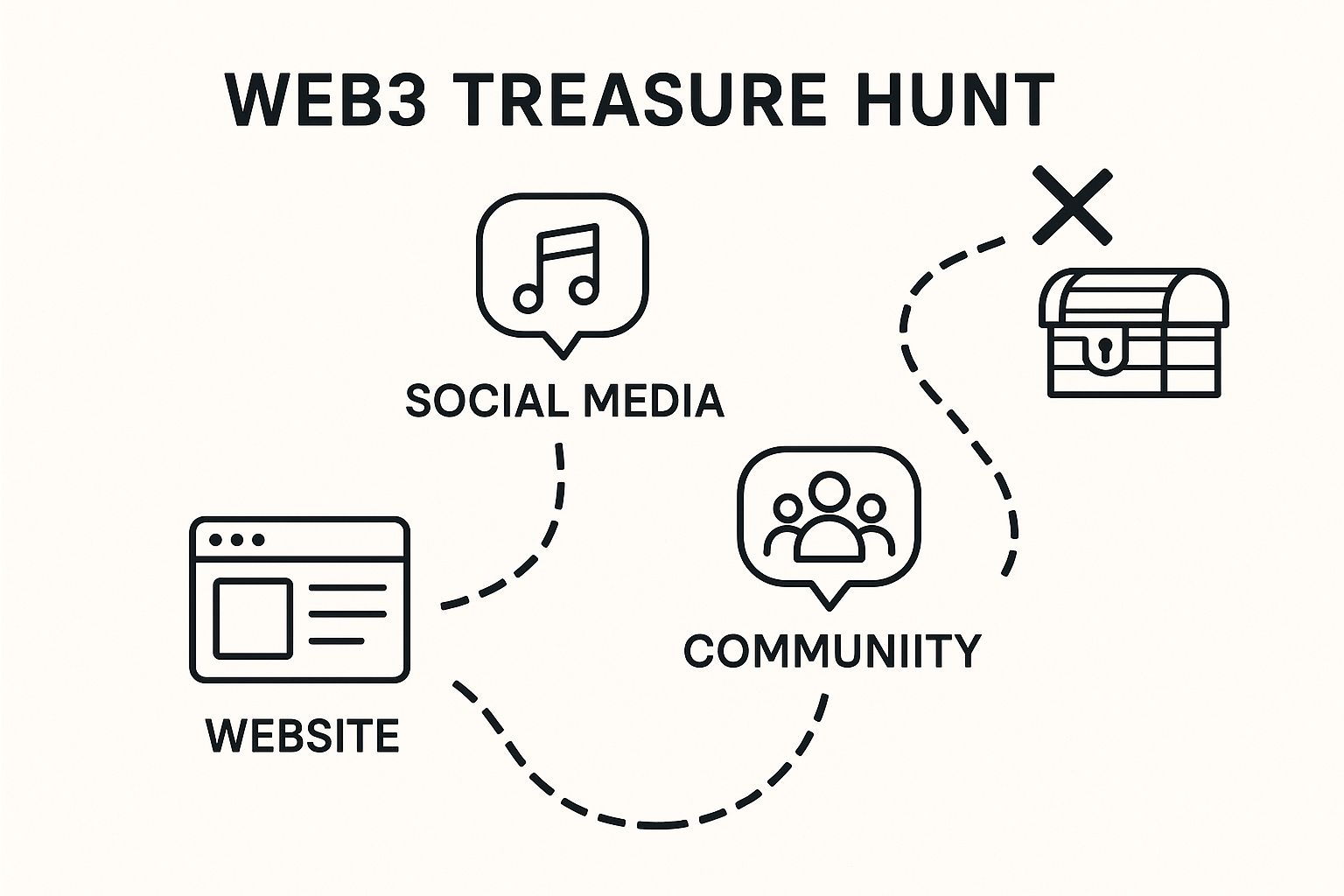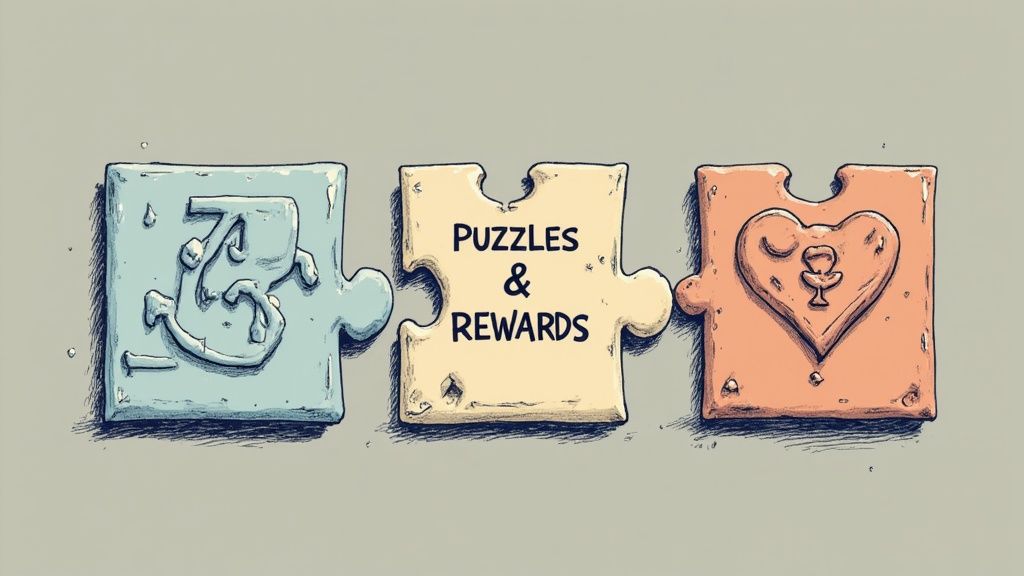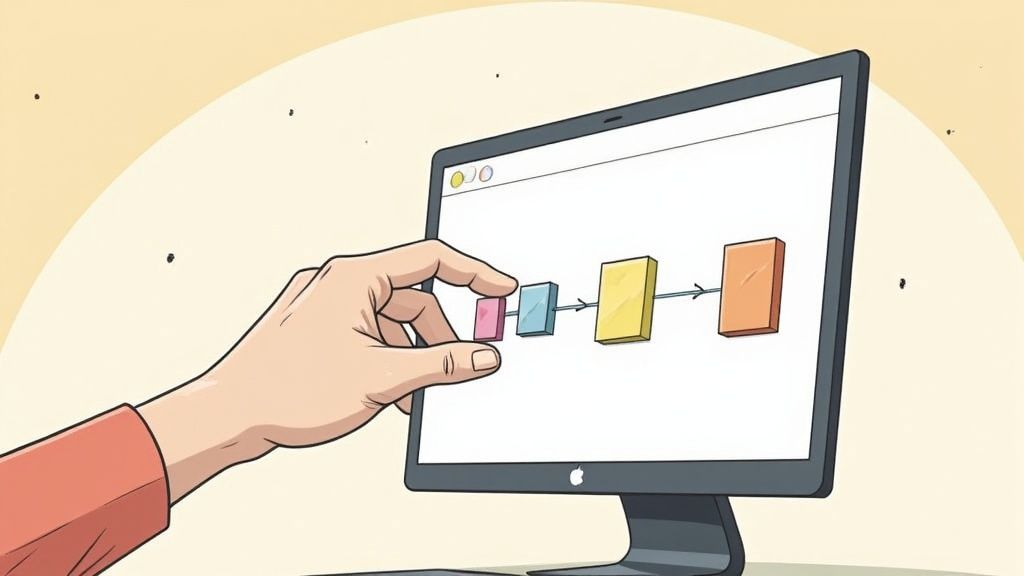The Treasure Hunt: Launch an Unforgettable Web3 Adventure

Ever felt like most crypto marketing is just… noise? Instead of yelling into the void, what if you could turn onboarding and education into a game? That's the whole idea behind a Web3 treasure hunt. It’s an interactive, gamified journey that pulls your community right into the heart of your project's ecosystem.
This isn't about passive marketing. It's about inviting people to solve clues and tackle tasks to earn digital rewards, transforming a potentially dry learning curve into an exciting adventure.
What Exactly Is a Web3 Treasure Hunt?
Think of it as a digital scavenger hunt, but for your project. You create a series of interconnected tasks that guide people on a hand-picked tour of your most important spots—your website, social media, and community hubs like Discord or Telegram.
Instead of just telling users about your project, you're showing them. You might ask them to follow your X (formerly Twitter) account, pop into your Discord, or even skim your whitepaper for a hidden code. Each step they complete unlocks the next, creating a narrative that pulls them deeper into your world.
This infographic breaks down how a treasure hunt can steer users through the key touchpoints of your ecosystem.

As you can see, it’s a strategic way to turn passive lurkers into active, educated members of your community.
A Modern Twist on an Old Adventure
Let’s be honest, the thrill of the hunt is timeless. It’s a core part of human nature. This appeal isn’t just a thing of the past, either. In the real world, treasure finds in England, Wales, and Northern Ireland jumped from a mere 24 in 1996 to a record-breaking 1,378 in 2022. A whopping 96% of those were found by folks with metal detectors. You can even read more about this treasure hunting boom on Sky News.
In Web3, the "treasure" isn't buried gold. It's something just as valuable: digital assets, exclusive access, or a genuine connection with a project. This gamified approach flips marketing from a one-way street into a hands-on, two-way experience.
When users participate, they aren't just consumers; they become explorers. They’re actively learning the ins and outs of your project, connecting with other community members, and building a real sense of ownership. It’s a far more powerful way to build a loyal base than traditional ads because it’s founded on discovery and reward, not interruption.
It's marketing that doesn't feel like marketing at all.
The Anatomy of a Killer Treasure Hunt
A great treasure hunt isn't just a list of things to do; it’s an adventure. It's what separates a boring checklist from a genuine experience that grabs your community’s attention and doesn’t let go. To build a campaign that really lands, you need to seamlessly blend a few key ingredients.
This is about more than just stringing a few tasks together. Before you even think about the Web3 side of things, it’s smart to get a handle on the basics of creating an effective marketing campaign. That foundational thinking is what helps you set clear goals right from the start.

Weave a Good Story
Every legendary quest needs a story. A compelling narrative is the glue that holds your entire treasure hunt together, making people actually care about the journey. It gives context to every click and every task, transforming a marketing campaign into a chapter in a larger saga.
Think of it like a movie plot. You have a hero (your user), a prize to be won, and a bunch of interesting challenges standing in their way. That simple framework is what makes the whole thing feel immersive.
A well-crafted narrative elevates a campaign from a series of transactional tasks to a memorable adventure that builds a genuine connection between the user and your brand.
To help you get started, here's a quick breakdown of the essential components you'll need to think about.
Core Components of a Web3 Treasure Hunt
This table outlines the foundational pieces required to design and launch a treasure hunt that people will actually want to complete.
| Component | Description | Example |
|---|---|---|
| The Narrative | The overarching story that gives context and purpose to the hunt. | "Recover the lost ancient artifact from a rival faction by collecting three hidden shards." |
| Puzzles & Tasks | A series of on-chain and off-chain challenges for participants to solve. | Following on X, joining a Discord, minting a free NFT, and answering a riddle. |
| Rewards System | The incentives that motivate users to complete the entire hunt. | A limited-edition NFT, a special Discord role, or a token airdrop. |
Each of these components plays a crucial role. A good story without engaging tasks falls flat, and great tasks without a compelling reward will be ignored. They all have to work together.
Design Puzzles That Hook People In
The actual challenges are the heart of your treasure hunt. The trick is to hit that perfect balance between being too easy and being so hard that people give up. Tasks should be clear enough for a total newbie to figure out but still offer a real sense of accomplishment when completed.
A smart hunt mixes up the types of activities to keep things fresh. You can combine on-chain and off-chain tasks to guide users through every nook and cranny of your project. For instance, a single quest could involve:
- Social Sluething: Finding a secret code by following your X account or joining a Discord channel.
- Knowledge Checks: Answering a question based on a clue hidden in your whitepaper or a blog post.
- Web3 Actions: Minting a specific NFT or using one of your dApp’s features for the first time.
By blending these together, you create a dynamic journey that teaches people about your project while keeping them hooked. This is often where automation comes in handy; you can learn more about this in our guide on marketing automation best practices.
Make the Treasure Worth the Hunt
And finally, what's the point of a hunt without some killer treasure at the end? The rewards are the main reason people will stick around. While a huge prize is always a draw, the best rewards aren't just about the money.
An effective reward structure can include things like:
- Exclusive NFTs: Cool digital collectibles that prove you finished the hunt and give you serious bragging rights.
- Special Status: A unique role in your Discord server that unlocks private channels or other perks.
- Whitelist Access: A guaranteed ticket to an upcoming mint or product release.
- Token Airdrops: A direct reward of your project's own currency.
The best rewards tie directly into what your project is all about, offering real value or status within the community. They’re the perfect final piece that makes the entire journey feel worthwhile.
Why a Treasure Hunt Actually Drives Real Growth
So, let's get real. Beyond the fun and games, a well-designed treasure hunt is a serious engine for real, measurable growth. This isn't about passive marketing where you just hope people pay attention. It's about turning your audience into active players, creating a powerful loop of engagement that hits your most important goals. We're not talking about a temporary spike in excitement; this is a strategic play for building a community that lasts.
These campaigns build real connections because they're all about shared experiences. When people team up in your Discord to crack a tough clue or celebrate finishing a quest, they aren't just interacting with your brand—they're building friendships with each other. That’s how you turn a random group of followers into a tight-knit community where people feel like they actually belong.
A Smarter Way to Get People Onboard
Let's be honest, one of the biggest walls people hit in Web3 is the intimidating learning curve. A treasure hunt completely flattens that curve by making education feel like an adventure. Instead of forcing users to slog through dense documentation, you guide them through your product’s features one fun step at a time.
Think about it: a task might require them to use a specific function of your dApp to uncover the next clue. This hands-on approach is brilliant because it accomplishes a few things at once:
- Teaches Without a Textbook: People learn by doing, which makes the information stick.
- Spurs Product Adoption: It gets them using your core features right out of the gate.
- Eliminates Friction: The whole onboarding process feels like a game, not a chore.
By the time the hunt is over, participants don't just know about your product; they actually know how to use it. You've just created a base of educated, confident users who are way more likely to stick around for the long haul.
Boosting the Metrics That Matter
At the end of the day, any campaign has to deliver results. The treasure hunt is a beast when it comes to driving key performance indicators (KPIs) across the board. The mix of collaboration and competition naturally creates social media buzz as people share their progress and ask for help. That’s word-of-mouth marketing at its most authentic and powerful.
To truly understand why a treasure hunt drives real growth, it's essential to apply robust metrics, much like effective strategies for measuring content marketing ROI.
The results really do speak for themselves. You'll see measurable jumps in wallet connections, dApp interactions, and social engagement. And by making "Join our Discord" a key step in the hunt, you’re directly funneling new, engaged members into your community. These are the kinds of strategies that are essential for lasting Discord server growth and building a truly vibrant home for your project.
How to Build Your First Hunt With Domino
Okay, enough with the theory—let's get our hands dirty. Building your first Web3 treasure hunt can sound intimidating, but with a no-code toolkit like Domino, it’s actually pretty simple. This is the fun part, where you turn your ideas into a real, live campaign without needing to write a single line of code.
Think of it like building with LEGOs. Domino gives you all the blocks—the tasks, the rewards, the rules—and you just snap them together to create whatever you can imagine. You don’t need to be an engineer to understand how it works; you just focus on making the experience awesome for your community.
Every great adventure starts with a single step, right? The thrill of a modern treasure hunt isn't so different from historical quests for gold. Fun fact: the estimated value of all sunken treasure scattered across the ocean floor is around $60 billion, a staggering number pulled together from centuries of shipwreck records. You can actually read more about the fascinating history of real-world treasure hunting over at Popular Mechanics.
Start with Clear Objectives
Before you even think about dragging and dropping tasks, you need a map. What's the point of this whole thing? Your goals are going to steer every single decision you make from here on out.
What are you trying to accomplish?
- Grow your community? Easy. Your tasks should be all about getting people to join your Discord or follow you on social media.
- Show off your product? Perfect. Create quests that walk users through the coolest features of your dApp.
- Boost brand awareness? Get people talking. Incentivize them to create content, like sharing their experience on X (formerly Twitter).
Nailing down your main objective is what separates a random list of chores from a smart, strategic campaign that actually gets you results.
Map Out Your Questline
Once you know where you're going, it's time to draw the path. Domino has a visual builder that lets you lay out the entire journey, creating a logical flow from one challenge to the next.
This is where you can see your whole campaign in one place, right inside the Domino interface.

The drag-and-drop setup makes it a breeze to structure tasks, create dependencies (like "you can't do B until you've done A"), and really visualize what your players will experience.
You can mix and match all kinds of activities, both on-chain and off-chain, to build a rich, engaging quest. To get more ideas, check out our guide on creating a powerful treasure hunt app. This kind of flexibility lets you guide people smoothly across your entire digital footprint.
The best questlines tell a story. Each task should feel like the next chapter, building up the hype as players get closer to the final prize.
Think about a simple three-step quest:
- The Hook: Start with something super easy and off-chain, like following your project on X. This gets people in the door with zero friction.
- The Challenge: Next, ask for a bit more investment. Maybe they have to answer a quiz about your whitepaper.
- The Web3 Action: End with a bang. Have them do something on-chain, like minting a commemorative NFT, to give them a real taste of your ecosystem.
This kind of structure slowly ramps up the engagement without scaring off newcomers.
Configure Tasks and Automate Rewards
With your path laid out, it's time to fill in the details. Domino comes loaded with over 130 quest templates, so setting up common actions takes seconds. You can ask users to connect their wallet, verify a tweet they made, or even check for a specific on-chain transaction.
The best part? The platform handles all the boring verification work for you. AI-powered systems automatically confirm that tasks were completed correctly, which stops cheating and saves you from hours of soul-crushing manual checks.
Finally, you get to set up the rewards. Decide what people will get for their efforts—an exclusive NFT, a special role in Discord, a token airdrop—and Domino will automatically send it the second they finish. That instant gratification is key to keeping players hooked and making the whole experience feel worthwhile.
Common Mistakes and How to Sidestep Them
Treasure hunts can be a huge win for your community, but a few common slip-ups can easily turn a fun adventure into a frustrating mess. Knowing what to watch out for is half the battle in creating a campaign that people actually enjoy, rather than one they complain about.
One of the biggest blunders is getting the difficulty level wrong. If your puzzles are a cakewalk, people will get bored and bounce. But if they're so cryptic that only a cryptographer could solve them, everyone will just give up. You're aiming for that sweet spot: a challenge that feels rewarding, not punishing.
Balancing the Challenge
Nailing the difficulty is all about thoughtful design. You have to cater to both the curious newcomers and your seasoned community members, which means the experience can't be one-size-fits-all.
A solid strategy is to build a questline with a gentle learning curve:
- Start Simple: Kick things off with easy, off-chain tasks. Think: follow us on X or join the Discord. This gets people in the door and builds some early momentum.
- Introduce Complexity: Next, layer in some slightly more involved steps. Maybe they need to find a secret word in your whitepaper or watch a quick tutorial video.
- End with a Web3 Action: The grand finale should be something on-chain, like minting a free NFT. It’s a satisfying final step that solidifies their journey.
This layered approach makes sure anyone can jump in and have fun, while still giving a real sense of accomplishment to the folks who see it through to the end.
A great treasure hunt should feel like a guided discovery, not an exclusive competition. You want it to be accessible enough for newbies but still interesting for your power users.
Maintaining Trust and Security
Another pitfall? Fuzzy rules. Be crystal clear about the rules of the game right from the start. Ambiguity is a recipe for confusion and accusations of unfairness. Spell out exactly what counts as a valid entry and how the rewards will be handed out. That kind of transparency builds trust and makes everyone feel like they have a fair shot.
Just as important is guarding your campaign against bots and cheaters. Believe me, they're always looking for an angle. Security is non-negotiable here. The world of treasure hunting has always attracted people trying to game the system. In the physical world, the illegal artifact trade is a massive six billion U.S. dollar industry every year, partly because it's so hard to catch the bad guys. You can even read about how real-world treasure hunting faces security challenges from Harvard International Review.
In Web3, this means putting strong security measures in place. Use tools that can sniff out bot activity, verify that participants are actual humans, and confirm that on-chain actions are legit. Securing your campaign isn't just about protecting the prizes; it’s about protecting the integrity of the treasure hunt itself. It ensures the rewards go to real community members, which makes their effort feel valued.
Got Questions About Treasure Hunts? We’ve Got Answers.
Even the most experienced Web3 marketers have a few questions before launching a big campaign. It's the small details that make a treasure hunt truly memorable, so let's walk through some of the most common things people ask.
We'll get into the nitty-gritty of budgeting, picking the right prizes, and figuring out how long your hunt should run. The idea is to give you the confidence to nail your strategy and get this thing live.
How Much Should I Actually Budget for This?
There’s no one-size-fits-all answer here. Your budget really just comes down to your goals and how big you want to go. A simple hunt to get more followers on X (formerly Twitter) might just need a small prize pool to get off the ground. But if you’re planning a huge, multi-week event to get people using your dApp, you'll obviously need to invest more.
The trick is to start with the end in mind. Figure out what a "win" looks like for you, and then build your budget around that.
A solid budget usually breaks down into three key areas:
- The Prize Pool: This is the total value of what you're giving away, whether it's NFTs, token airdrops, or even some cool physical merch.
- Platform Costs: Think about any fees for using a no-code tool like Domino to build and run the whole thing smoothly.
- Promotion: This is whatever you plan to spend on ads, influencer shout-outs, or anything else to spread the word.
And don't forget, the return on your investment isn't just about direct numbers. The buzz and community vibe you create can pay dividends long after the last prize is claimed.
What Kind of Rewards Actually Work?
Listen, the best rewards aren't always the ones with the biggest price tags. They’re the ones your audience genuinely wants. A huge cash prize will definitely get eyes on your campaign, but you'll attract a lot of people who are just there for the money and will ghost you the second it's over.
Great rewards offer real value or status that means something inside your community. They should feel less like a payout and more like a badge of honor for being a true fan.
Think about offering rewards with some long-term perks or a bit of exclusivity. A limited-edition NFT that unlocks a private Discord channel or a whitelist spot for an upcoming mint? That’s the kind of stuff that builds real loyalty and makes people feel like they’ve earned something special.
How Long Should a Treasure Hunt Run?
This one’s a balancing act. Too short, and people might not even hear about it in time. Too long, and you’ll see people get tired and drop off, even your most hardcore fans.
For most projects, one to two weeks seems to be the sweet spot. It’s enough time to build some hype and let everyone jump in without feeling like they have to rush, but it's still short enough to keep things exciting. A quick, intense hunt over a single weekend can also be a killer move, especially if you’re tying it to a specific event like a product launch.
At the end of the day, you just have to test it out and see what your community responds to. Pay attention to the engagement data, and you can always tweak the timing for the next one.
Ready to create your own unforgettable adventure? With Domino, you can build, manage, and automate a Web3 treasure hunt in minutes—no code needed. See just how easy it is to drive real growth at https://domino.run.
Level Up Your dApps
Start using Domino in minutes. Use automations created by the others or build your own.
